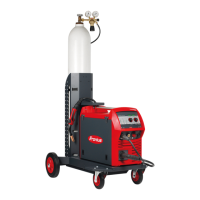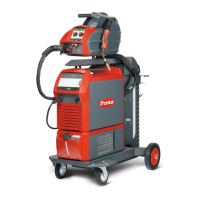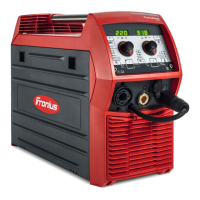Pulse welding
Applications Pulsed welding is welding with a pulsing welding current. It is used to weld steel pipes
out-of-position or to weld thin sheet metal.
In these applications, the welding current set at the start of welding is not always
optimum for the entire welding process:
- If the amperage is too low, the parent material will not be melted enough
- If overheating occurs, there is a danger that the liquid weld pool may drip.
Operating prin-
ciple
- A low base current I-G rises steeply to the significantly higher pulse current I-P and
drops back to the base current I-G after the Duty cycle dcY time.
- This results in an average current that is lower than the set pulse current I-P.
- During pulse welding, small sections of the welding location melt quickly and then
rapidly re-solidify.
The power source controls the "Duty cycle dcY" and "Base current I-G" parameters
according to the set pulse current (welding current) and pulse frequency.
1/F-P
I-P
I-G
I
t
t
up
t
down
I-S
I-E
dcY
Welding current progression curve
Adjustable parameters:
I-S Starting current
I-E Final current
F-P Pulse frequency (1/F-P = Time between two pulses)
I-P Pulse current (set welding current)
Fixed parameters:
t
up
UpSlope
t
down
DownSlope
dcY Duty cycle
I-G Base current
84

